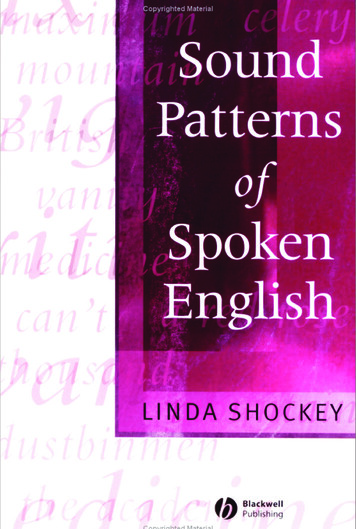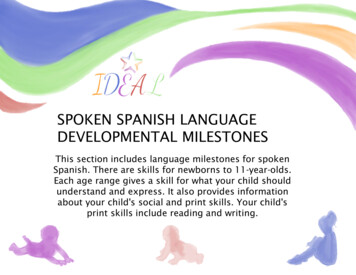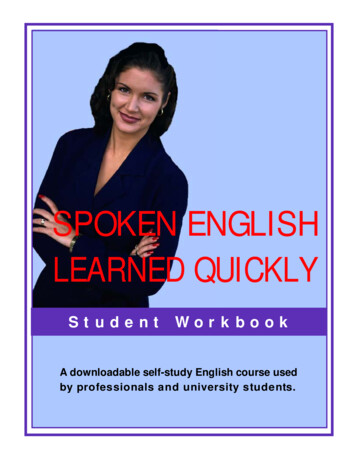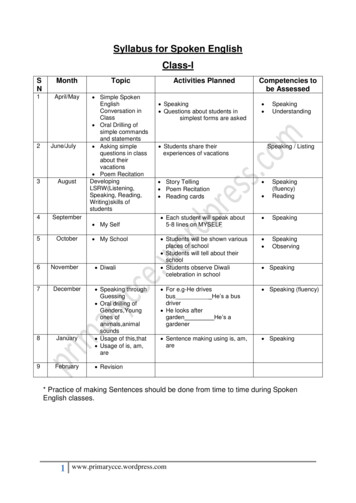
Transcription
“Success in spoken English lies in stress and vowel sounds: specifically, getting thecorrect vowel sounds on the correct stressed syllables in a sentence, and joiningthem together. This book will show you how to do that.” – Matt Purlandenglishbanana.com’sTalk a Lot.pdf file users:Click this icon (left) toaccess the contents!Spoken English Courseby Matt PurlandA Great New Way to Learn Spoken EnglishElementary Handbook General Information about Talk a Lot CoursesHow to Use Talk a Lot ResourcesFocus on Connected SpeechFocus on the International Phonetic Alphabet (IPA)100% Photocopiable – Free Copying Licence Included!
“Success in spoken English lies in stress and vowel sounds: specifically, getting thecorrect vowel sounds on the correct stressed syllables in a sentence, and joiningtogether the stresses. This book will show you how to do that.” – Matt Purlandenglishbanana.com’sTalk a LotSpoken English Courseby Matt PurlandA Great New Way to Learn Spoken EnglishElementary Handbook General Information about Talk a Lot CoursesHow to Use Talk a Lot ResourcesFocus on Connected SpeechFocus on the International Phonetic Alphabet (IPA)100% photocopiable – free copying licence included!
This book is dedicated with love and thanks as always to Anna and Julia, as wellas to Pat, who gave me my first full-time job teaching English, and to Helen, whoencouraged me to develop and exploreand also: .(Insert the name of the teacher who has most inspired you to learn)
English Banana.cominfo@englishbanana.comISBN-13: 978-0955701535The International Phonetic Alphabet (IPA) is Copyright the International Phonetic Association,and is used in this book with kind permission.English Banana.com Copying Licence:You may freely print, copy, distribute, sell, and give away this book, subject to our CopyingLicence (see pages viii-ix)First published in the UK by English Banana.com 20091.3 – 09/091.2 – 08/091.1 – 06/091.0 – 04/09( Consonant Clusters, Vowel Clusters, and The Magic “e” Rule)( Big Word Game, and Talk a Lot Bingo!)( Sound Connections Demo, Going Further, and Working Out Word Stress –Two-Syllable Words where the First Syllable is a Schwa: L]L)(Original edition) Copyright Matt Purland 2009
Talk a LotElementary HandbookContentsivviiixContentsIntroductionFree Copying LicenceBibliographyAGeneral Information1.General 61.27Plan of all Talk a Lot Units and ActivitiesCourse OutlineLesson OutlineAssessment Methods, Tests, and ExaminationStudent Course Report (Blank)Student Course Report (Example)Vocabulary Test (Blank)End of Course Oral Examination #1 (from Book 1)End of Course Oral Examination #2 (from Book 2)End of Course Oral Examination (Example)Certificate Template #1Certificate Template #2BHow to Use the Resources2.Sentence Blocks2.12.72.82.9InstructionsActivity Template (Blank)Sentence Blocks Q & ASentence Blocks – Six Great Tips for Students3.Connected Sentence Cards3.13.23.33.63.15InstructionsActivity Template (Blank)Sample Lesson PlanSound Connections DemoGoing Further4.Connected Speech Templates4.14.6InstructionsActivity Template (Blank)Sentence FocusActivitiesFor more fun worksheets, games and quizzes log onto www.englishbanana.com now!Talk a Lot Elementary English Banana.comi
Talk a LotElementary HandbookContents5.Discussion Words and Question Sheets5.15.45.55.65.9InstructionsDiscussion Words Activity Template (Blank)Question Sheets Activity Template (Blank)Discussion Words – Sample Lesson PlanBig Word Game & Talk a Lot Bingo!6.Information Exchanges6.16.3InstructionsActivity Template (Blank)7.Multi-Purpose Texts7.17.3InstructionsReading Race – Lesson Plan8.Discussion Questions8.18.2InstructionsActivity Template (Blank)9.Agree or Disagree9.19.39.49.6InstructionsActivity Template (Blank)How to Give a Small Group or Individual Presentation (Example and Notes)How to Give a Small Group or Individual Presentation (Blank Outline)10.Role Plays10.110.310.4InstructionsRole Plays – Mood ChartActivity Template (Blank)CFocus on Connected Speech11.What is Connected Speech?11.111.311.8What is Connected Speech? (Student’s Handout)The Techniques of Connected SpeechThe Techniques of Connected Speech – Matching Game12.What is Sentence Stress?12.112.612.9What is Sentence Stress?Sentence Stress in Starting Sentences from Elementary Book 1Stressed Syllables in Starting Sentences from Elementary Book 1Word FocusActivitiesFree PracticeActivitiesFor more fun worksheets, games and quizzes log onto www.englishbanana.com now!Talk a Lot Elementary English Banana.comii
Talk a LotElementary ssed Syllables & Vowel Sounds in Starting Sentences from Elementary Book 1Sentence Stress in Starting Sentences from Elementary Book 2Stressed Syllables in Starting Sentences from Elementary Book 2Stressed Syllables & Vowel Sounds in Starting Sentences from Elementary Book 2List of Common Contractions in EnglishSentence Stress – Activity Cards (Blank)13.What is Word Stress?13.113.313.613.713.8What is Word Stress?Analysis of Discussion Words in Elementary Book 2Discussion Words with Suffixes in Elementary Book 2Working Out Word Stress – Analysis of a Newspaper Article #114.Prefixes14.114.214.3Common Prefixes and What they IndicateCommon Prefixes and What they Indicate – Matching GameList of Noun/Verb Homographs15.Suffixes15.115.215.4Common Suffixes and What they IndicateCommon Suffixes and What they Indicate – Matching GameSuffixes and Word Stress16.Compound Nouns16.116.216.316.416.516.6300 Common Compound Nouns – Ordered by Same First WordCompound Nouns – Activity Sheet (First Words)Compound Nouns – Activity Sheet (First Words) – Answers300 Common Compound Nouns – Ordered by Same Second WordCompound Nouns – Activity Sheet (Second Words)Compound Nouns – Activity Sheet (Second Words) – Answers17.Weak Forms17.117.2Weak Forms – Information SheetWeak Forms – Complete the TableDFocus on the International Phonetic Alphabet (IPA)18.Learn the International Phonetic Alphabet (IPA)18.118.318.6Why Bother Learning the International Phonetic Alphabet?Learn the Sounds of English with the IPA – Sample Lesson PlanThe 48 Sounds of English with the International Phonetic AlphabetWorking Out Word Stress – Two-Syllable Words where the First Syllable is a Schwa:L]LFor more fun worksheets, games and quizzes log onto www.englishbanana.com now!Talk a Lot Elementary English Banana.comiii
Talk a LotElementary 8.4618.4818.5518.5918.6218.6418.65Flashcards – InstructionsFlashcardsRhyming Words – Vowel SoundsRhyming Words – DiphthongsDiscussion Words from Elementary Book 1 (with the IPA)Discussion Words from Elementary Book 2 (with the IPA)Spelling and Sounds – Consonant ClustersSpelling and Sounds – Common Consonant Clusters (Student’s Handout)Spelling and Sounds – Vowel ClustersList of Vowel Clusters – In Alphabetical OrderSpelling and Sounds – Common Vowel Clusters (Student’s Handout)Spelling and Sounds – The Magic “e” RuleSpelling and Sounds – 250 Common Magic “e” Words (in Alphabetical Order)Spelling and Sounds – 250 Common Magic “e” Words (Ordered by Final Consonant)19.IPA Practice Worksheets and Tests19.119.219.319.4Translate Animal Names from the IPA 1Translate Animal Names into the IPA 1Translate Animal Names from the IPA 2Translate Animal Names into the IPA 219.519.619.719.8Translate Irregular Verbs from the IPA 1Translate Irregular Verbs into the IPA 1Translate Irregular Verbs from the IPA 2Translate Irregular Verbs into the IPA 219.919.1019.1119.12Translate Signs and Notices from the IPA 1Translate Signs and Notices into the IPA 1Translate Signs and Notices from the IPA 2Translate Signs and Notices into the IPA 219.1319.1419.1519.16Translate Slang Phrases (Adjectives) into the IPATranslate Slang Phrases (Adjectives) into the IPA – AnswersTranslate Slang Phrases (Nouns) into the IPATranslate Slang Phrases (Nouns) into the IPA – Answers19.1719.18IPA Test 1IPA Test 1 – Answers19.1919.20IPA Test 2IPA Test 2 – Answers19.2119.22IPA Test 3IPA Test 3 – Answers19.2319.24IPA Test 4IPA Test 4 – Answers(Note: the worksheets on pp.19.1-19.12 act as pairs, with each providing the answers for the other)For more fun worksheets, games and quizzes log onto www.englishbanana.com now!Talk a Lot Elementary English Banana.comiv
Talk a LotElementary HandbookIntroductionHello, and welcome to the Talk a Lot Elementary Handbook!This handbook shows you how to use Talk a Lot materials to learn or teach spoken English,as well as providing background information and practice worksheets on related topics, suchas connected speech, sentence and word stress, and the International Phonetic Alphabet(IPA).The Talk a Lot course objectives are very simple: Every student talking in EnglishEvery student listening to and understanding EnglishEvery student thinking in English, andEvery student taking part in classTalk a Lot is structured so that every student can practise and improve English grammar,vocabulary, pronunciation, fluency, word and sentence stress, and interpersonal skills, byworking in pairs, groups and one to one with the teacher.The main benefits of Talk a Lot are: Students have to think in English during lessons in a controlled and focused wayStudents learn how to memorise correct English structures naturally, without abstractand unrelated grammar lessonsStudents learn how to construct eight different common verb forms, using positive,negative and question forms, as well as embedded grammar appropriate to theirlevel. The verb forms studied are: Present Simple, Present Continuous, Past Simple,Past Continuous, Present Perfect, Modal Verbs, Future Forms, and First ConditionalStudents learn many essential vocabulary words by heart, including word stress andthe sounds of EnglishStudents learn how to become more fluent when speaking in English, by joiningtogether words in a sentence using the techniques of connected speechStudents enjoy following a simple and effective method that produces results quicklySo far we’ve published two Talk a Lot Elementary books. The ten lesson topics studied inTalk a Lot Elementary Book 1 are:Town, Food, Shopping, Health, Transport, Clothes, Work, Family, Home, and Free Timewhilst the ten lesson topics studied in Talk a Lot Elementary Book 2 are:Crime, Sport, Music, Weather, Animals, Cars, The Human Body, Colours and Numbers,Life Events, and NatureA third Talk a Lot Elementary book is currently in preparation, with the following brand newlesson topics:For more fun worksheets, games and quizzes log onto www.englishbanana.com now!Talk a Lot Elementary English Banana.comv
Talk a LotElementary HandbookIntroductionLearning English, Films, Hospital, Books, Airport, Television, Education, Money,The Environment, and HolidaysImportant NoteThis book is the Talk a Lot Elementary Handbook, and doesn’t contain the materials forTalk a Lot courses. This book gives instructions and guidance for using the materials, whichcan be found in the existing two Talk a Lot course books. You can download the coursebooks for free from http://www.englishbanana.com, or buy hard copy versions from any goodbookseller. Downloadable course materials for Book 3 will be added to our website in stages,so please check back regularly to see what is available to download!You can see how all of the different units and activities from the three Talk a LotElementary course books fit together on P.1.1.As well as containing instructions about how to use Talk a Lot materials, this handbook alsoprovides information sheets and practice worksheets to help students learn skills that willaccelerate their improvement in spoken English: how to identify and use the techniques of connected speech (from p.11.1)how to identify and use sentence stress (from p.12.1)how to identify word stress (from p.13.1)how to identify prefixes (from p.14.1)how to identify suffixes (from p.15.1)how to identify compound nouns (from p.16.1)how to identify weak forms (from p.17.1)learn the sounds of English with the International Phonetic Alphabet (from p.18.1)how to identify vowel sounds (from p.18.19)This handbook is not intended to be an exhaustive academic work. The aim was to write abrief, helpful guide and pack of resources that would provide a way into practise andlanguage work in the classroom, rather than a dry, analytical manual. For example, I havedeliberately avoided confusing jargon when writing about connected speech. Phrases like“bilabial plosive” and “palato-alveolar approximate” – though fun to say – can be studied later,or at the student’s leisure. (See the bibliography on p.x for ideas about further reading.)The sentence stress activities in this course are focused on neutral speech. Intonation islargely ignored – except where it concerns yes/no question forms – in favour of groundingstudents in the basics of word stress, sentence stress, and connected speech techniques.The subtleties of intonation, and how meaning can be altered, can of course be practised inconjunction with Talk a Lot materials, but should perhaps come later on for new students ofspoken English, after they have mastered the techniques demonstrated in this handbook.My aim in writing Talk a Lot materials is always to be as non-prescriptive as possible, sothat users may take what they want from the work and use it in the way that best fits theirFor more fun worksheets, games and quizzes log onto www.englishbanana.com now!Talk a Lot Elementary English Banana.comvi
Talk a LotElementary HandbookIntroductionsituation. In my experience these materials are tried and tested and have been proven towork in the classroom.If you have any questions after studying this handbook and the Talk a Lot course materials,please do feel free to get in touch with us, either by email at info@englishbanana.com, or viaour feedback form at:http://www.englishbanana.com/contact.htmlAs ever, we owe a big debt of gratitude to everybody who has been using Talk a Lotmaterials over the past year or so. Thanks for your feedback. It really helps! We’ve had lots offun in the classroom with these lessons, and we hope that you will too! We’d love to hear fromyou about how you have used this book and how your course went, so please feel free tocontact us. We’d also be really excited to hear about your ideas and proposals for new Talka Lot topics and activities that we could include in future Talk a Lot materials.With best wishes for a successful course,Matt Purland, Ostróda, Poland (28th March 2009)For more fun worksheets, games and quizzes log onto www.englishbanana.com now!Talk a Lot Elementary English Banana.comvii
Talk a LotElementary HandbookFree Copying Licence“There is no wealth but life.” – John Ruskin (1819-1900)Quick Summary:You may download, print, copy, sell, and distribute English Banana.com materials, withoutpaying anything.Definition of Terms:thThis licence is effective from 7 December 2008, and replaces all existing statements andnotices regarding copyright and copying of English Banana.com materials. It applies to allEnglish Banana.com materials.“English Banana.com materials” means: worksheets, MP3s, video files, books, CD-ROMs,and any other file or product that has been created and published by English Banana.com,that exists either on its website server (www.englishbanana.com) or offline, including digitalversions (e.g. a .pdf file) as well as physical copies (e.g. a workbook copy of the Big GrammarBook, or a CD-ROM).Who May Use this Licence?This licence applies to anybody who wishes to use English Banana.com materials.Free Copying Licence:1.2.3.4.5.6.7.You may download, print, copy, and distribute English Banana.com materials.You may sell English Banana.com materials to make a profit.You may distribute English Banana.com materials for free.You may put English Banana.com materials on a website.You may put English Banana.com materials on an intranet server.You may adapt English Banana.com materials.You may remove the English Banana.com name and logo from the materials, orreplace it with your own.8. You may produce plays or films using English Banana.com materials.This is a free licence: You don’t have to pay English Banana.com any royalties or fees.You don’t have to credit English Banana.com as the originator of the materials.You don’t have to contact us before using this licence, or apply for further permission,although if you do tell us how you are using it, we may be able to help you bypublicising your initiative on English Banana.com.In short, if you can use English Banana.com materials in any way, this licence gives youpermission to use them.For more fun worksheets, games and quizzes log onto www.englishbanana.com now!Talk a Lot Elementary English Banana.comviii
Talk a LotElementary HandbookFree Copying LicenceThere is only one restriction:You may not claim copyright to original English Banana.com materials. International copyrightfor English Banana.com materials belongs to Matt Purland/English Banana.com 2002-2009.Why Free Licences?Matt Purland, sole author of all English Banana.com materials, writes:“I feel that the quotation at the top of this page says it all: ‘There is no wealth but life.’ What dowe have of value, really, apart from life? Life is fleeting, so if somebody sees value in my work– the English Banana.com materials – and can use it to improve their quality of life, I’m veryhappy for them to do so. I hope that perhaps you will be able to benefit from one or both FreeEnglish Banana.com Licences. If you would like to ask me a question, or send a comment,please do contact me via the English Banana.com feedback form.”Standard Disclaimer:By accessing and using www.englishbanana.com you accept that all materials and services,including links to external websites, are provided in good faith and ‘as is’. You agree that youwill not hold English Banana.com responsible for any issues or consequences that may arisefrom accessing and using English Banana.com materials. No guarantee of availability orreliability of either use or accuracy is given by the author or may be assumed. All files onwww.englishbanana.com have been virus-checked before being uploaded to the server.However, this disclaimer has been posted to make it clear that when users download filesfrom this website they do so at their own risk. English Banana.com cannot be heldresponsible or liable for any damage or loss resulting from accessing and using materialsfrom www.englishbanana.com.Authorisation:This English Banana.com Free Licence has been written, authorised, and digitally signed bythe sole author of all English Banana.com materials, Matt Purland:Matt Purland, Founder and Writer, English Banana.com, Date: 7th December 2008For more fun worksheets, games and quizzes log onto www.englishbanana.com now!Talk a Lot Elementary English Banana.comix
Talk a LotElementary HandbookBibliographySuggestions for further reading on the topic of spoken English:English Phonetics and Phonology: A Practical CoursePeter RoachCambridge University Press, 1983How to Teach PronunciationGerald KellyLongman, 2000Learner English (Second Edition)Ed. Michael Swan & Bernard SmithCambridge University Press, 2001Lucy Cowdery’s Spelling RulebookLucy CowderyTRTS, 2001Modern British and American English Pronunciation: A Basic TextbookBurkhard DretzkeUTB für Wissenschaft Uni-Taschenbucher GmbH, 1998Sound FoundationsAdrian UnderhillHeinemann, 1994Teaching PronunciationM. Celce-Murcia, D. M. Brinton, J. M. GoodwinCambridge University Press, 1996For more fun worksheets, games and quizzes log onto www.englishbanana.com now!Talk a Lot Elementary English Banana.comx
A General InformationContentsGeneral Information1.Plan of all Talk a Lot Units and ActivitiesCourse OutlineLesson OutlineAssessment Methods, Tests, and ExaminationStudent Course Report (Blank)Student Course Report (Example)Vocabulary Test (Blank)End of Course Oral Examination #1 (from Book 1)End of Course Oral Examination #2 (from Book 2)End of Course Oral Examination (Example)Certificate Template #1Certificate Template #21.11.21.31.61.111.121.131.141.181.221.261.27
Talk a LotGeneral InformationPlan of all Talk a Lot Units and ActivitiesThis page shows all of the units and activities from the first three Talk a Lot Elementary books.A 3 indicates that the material for this activity has been published and can be found online at:http://www.englishbanana.com/talkalot/ Note: we hope to update this page regularly, as more materialis added to each Talk a Lot unit! (Page last updated 08/2009)Sentence FocusWord FocusFree PracticeUnit / ActivitySBsCCsCTsDWsDWQsIEsMPTsDQsAGsRPsVTsLTsHow to Use33333333333312345678910Elementary Book 1:TownFood and ree ntary Book 2:CrimeSportMusicWeatherAnimalsCarsThe Human BodyColours and NumbersLife 3312345678910Elementary Book 3:Learning nMoneyThe 3333KEYSentence Focus Activities:SBs (Sentence Blocks); CCs (Connected Sentence Cards);CTs (Connected Speech Templates)Word Focus Activities:DWs (Discussion Words); DWQs (Discussion Word Questions);IEs (Information Exchanges); MPTs (Multi-Purpose Texts)Free Practice Activities:DQs (Discussion Questions); AGs (Agree or Disagree?);RPs (Role Plays)Tests:VTs (Vocabulary Tests); LTs (Lesson Tests)For more fun worksheets, games and quizzes log onto www.englishbanana.com now!Talk a Lot Elementary English Banana.com1.1
Talk a LotGeneral InformationCourse Outline Before the course begins perform an initial assessment with each student to checkthat they are at a suitable level for the course, and then enrol them onto the course.This course is aimed at students who are at a good elementary level or preintermediate level. For this course we recommend that there are no more than tenstudents per class. Before we start, the Talk a Lot course materials are designed to be flexible, and canbe used in any way that you find suitable for your group or your needs. The courseoutline below is just an example, so please don’t feel that you have to follow it to theletter! The course is divided into twelve three-hour lessons. The first ten lessons each havea different topic; while lesson 11 is intended for the revision of material studied overthe ten weeks, and lesson 12 is reserved for the students’ examinations and an endof course review. We recommend that you hold one lesson per week, making this atwelve week course comprising 30 guided learning hours, plus 6 hours of guidedrevision and examination. It’s up to you what order you do the lessons in; you don’thave to follow our order of topics! If your students need more than three hours of study per week, why not offer themtwo 3-hour lessons per week: one Talk a Lot lesson, as described below, and onelesson using traditional teaching methods, which include conventional reading, writingand grammar-based activities that could complement the intensive speaking andlistening work of the Talk a Lot lessons. You could follow a standard EFL or ESLcourse book such as New English File or New Headway, using material thatcomplements the Talk a Lot lesson, so, for example, if your Talk a Lot lesson was onthe topic of Sport, you could use material from a traditional course book on the sametopic for the second lesson. This would then give you a course with 60 guidedlearning hours.For more fun worksheets, games and quizzes log onto www.englishbanana.com now!Talk a Lot Elementary English Banana.com1.2
Talk a LotGeneral InformationLesson Outline In our example lesson outline, each lesson lasts for three hours (180 teachingminutes). This can vary according to your needs, for example, in some Englishlanguage classrooms one teaching hour is equal to 45 minutes, and so 3 teachinghours would be 2¼ hours. Or it may be that you have only 2 hours per week with yourgroup of students. You can still use Talk a Lot activities to serve up a satisfying andstimulating lesson – just in a shorter timeframe. Each lesson focuses on a specific vocabulary topic. Books 1 and 2 each contain tendifferent topics, and Book 3 will also have 10 new topics. Book 3 also introducesseveral brand new activities – e.g. Multi-Purpose Texts – so that teachers now havean even greater variety of possible things to do in each lesson. For each lesson theteacher can now draw from twelve different activities in four practice categories:Sentence Focus Activities: Sentence Blocks (C)Connected Sentence CardsConnected Speech TemplatesWord Focus Activities: Discussion Words and Question SheetsInformation ExchangeMulti-Purpose TextsFree Practice Activities: Discussion QuestionsAgree or Disagree?Role PlaysShow and Tell (C)Continuous Assessment Tests: Vocabulary Test (C)Lesson Test (C)The activities marked with (C) are, we believe, core activities that should be includedin every Talk a Lot lesson. Of course, it’s up to you whether you want to do this!However, it is not necessary to use every activity in every lesson. There is far morematerial in each Talk a Lot unit than is needed to fill three hours of lesson time, so theteacher can mix and match, using different activities from different practice categoriesin different lessons, according to the needs of their learners. Similarly, it is notnecessary to do the activities in the same order (as stated below) in every lesson, butbetter to mix things up each time so that students don’t become used to a set lessonorder.The core activities provide a reassuring routine for each lesson. For example, at thebeginning of each lesson students come together for the Vocabulary Test andFor more fun worksheets, games and quizzes log onto www.englishbanana.com now!Talk a Lot Elementary English Banana.com1.3
Talk a LotGeneral InformationLesson OutlineShow and Tell, and at the end of the lesson for Q & A time, and a preview of the nextlesson’s topic. Bearing that in mind, here is an example of how you could structure a 3-hour longTalk a Lot lesson:15 minsC. A. TestsCORE15 minsFree PracticeCORESentence FocusCOREWelcome and Vocabulary Test (see p.1.7) based on the previous lesson’stopic. The teacher reads out the twenty words to the students in their nativelanguage and they write them in English. The teacher gives back lessontests, discusses the answers with the students, and can also ask randomquestions from the previous lesson’s sentence blocks to check how much thestudents have remembered.The teacher introduces the topic of this lesson, for example, “Music”. Eachstudent has to Show and Tell an item to do with this topic, e.g. for “Music” astudent could bring a musical instrument, or a CD or poster, and then tell theclass about it. This free practice activity is an easy warm-up for students, anda way into the lesson topic. The teacher also brings something to “show andtell”, and then introduces the eight new Sentence Block starting sentencesand wh- questions on the board or on the handout (see p.2.1). It is essentialthat the teacher checks that the students understand the sentences, so thatthey are meaningful to students when they practise them later on.The teacher asks different students to model one or two of the sentenceblocks, which will act as a reminder to students of how to make the sentenceblocks.20 minsStudents make the sentence blocks in pairs, for example, sitting back to backwithout eye contact. They don’t write anything down and must not copy thesentence block starting sentences from the board. For this activity all the talkflows from the students making the sentence blocks from the startingsentences and wh- questions on the board or on the handout.10 minsNext, the teacher introduces the eight Discussion Questions for this lessonto the whole class (see p.8.1). Again, it is important that the teacher checksthat their students understand the vocabulary that is used. Students shouldbe encouraged to use their dictionaries to check new words.Free Practice30 minsWorking in pairs or small groups, students practise the discussion questions.This is free speaking practice – the antithesis of having to make pre-setsentences using the sentence blocks. The students can change partnersseveral times in order to get a good variety of practice, then the whole classcomes together and feeds back to the group, with the teacher askingadditional follow-up questions. During this time the teacher removes thesentence block sentences from the board, or asks the students to return theirsentence block handouts. This free practice session could be equallyeffective with the Agree or Disagree? activity (see p.9.1), or Role PlaysFor more fun worksheets, games and quizzes log onto www.englishbanana.com now!Talk a Lot Elementary English Banana.com1.4
Talk a LotGeneral InformationLesson Outline(see p.10.1), instead of the Discussion Questions. You could vary what yourstudents do lesson by lesson.We’re halfway through! Have a cup of tea and some fresh air – or just hang out!25 minsC. A. TestsCORE25 minsWord Focus30 minsSentence Focus10 minsFree PracticeCOREAfter a relaxing break it’s time for some brain work – the Lesson Test (seepage 1.8)! The aim of this test is for the teacher to find out what vocabularythe students can remember from the previous lesson and to get an idea ofhow well they are coping with making the sentence blocks.The next section is for word focus activities. The teacher could decide to usethis slot for activities with the Discussion Words and Question Sheets (seep.5.1), for doing the Information Exchange (see p.6.1), or for working withthe Multi-Purpose Texts (see p.7.1) – or you could base an activ
Spoken English Course by Matt Purland A Great New Way to Learn Spoken English Elementary Handbook General Information about Talk a Lot Courses How to Use Talk a Lot Resources Focus on Connected Speech Focus on the International Phonetic Alphabet (IPA) 100% Photocopiable – Free Co










